The data clearly indicates that the RWA value of Ethereum has entered a distinct growth cycle.
Written by: Sam @IOSG
TL;DR
Using the stablecoin bill as a starting point, introduce the recent public attention and discussion on RWA, and then discuss RWA on Ethereum.
Data analysis (zksync can be a highlight).
What impact will the emergence of Etherealize have on Ethereum?
Ethereum's stablecoin issuance has always had a strong moat with DeFi. With the new policies in the U.S., can RWA organically connect traditional finance and DeFi? As the most credible and decentralized blockchain, we continue to see the potential in Ethereum.
Catalysts and Market Attention
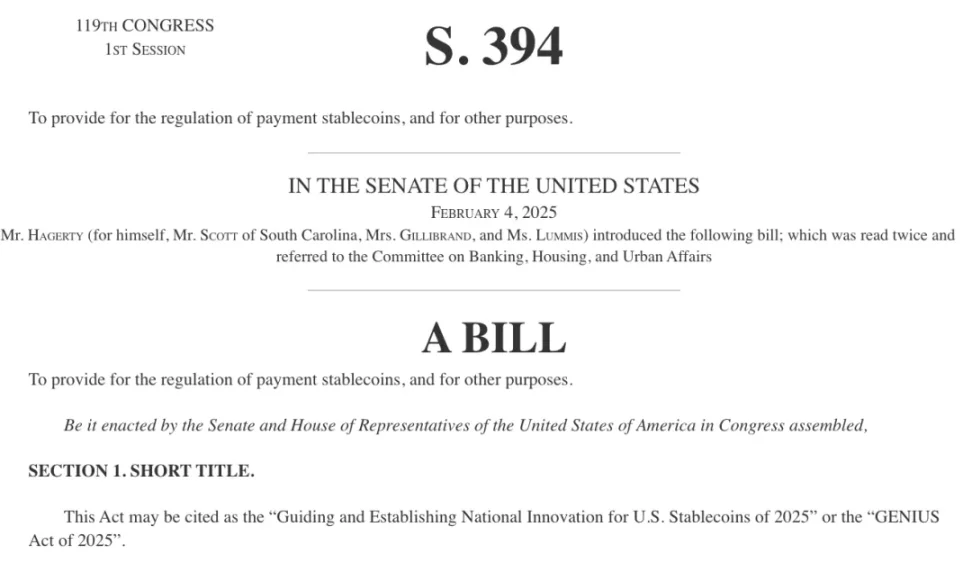
Against the backdrop of rapid evolution in traditional finance and regulatory environments, the recent passage of the "GENIUS Act" has reignited market interest in RWA. In addition to stablecoins and significant legislative progress, the RWA sector has quietly achieved several important milestones: a sustained strong growth trend and a series of notable breakthroughs—such as Kraken launching tokenized stocks and ETFs, Robinhood proposing to the SEC to grant token assets equal status with traditional assets, and Centrifuge issuing a decentralized JTRSY fund worth $400 million on Solana.
At this unprecedented level of market attention and with broader adoption of traditional finance on the horizon, it is crucial to closely examine the current RWA landscape—especially the position of leading platforms like Ethereum. RWA based on Ethereum has shown astonishing month-on-month growth, often maintaining double-digit highs; the growth rate in 2025 is expected to accelerate compared to the single-digit months of 2024. Another key factor driving this momentum is "Etherealize" as a catalyst for regulatory development, along with the Ethereum Foundation prioritizing RWA as a strategic focus. At this critical juncture, this article will delve into the development dynamics of RWA on Ethereum and its Layer-2 networks.
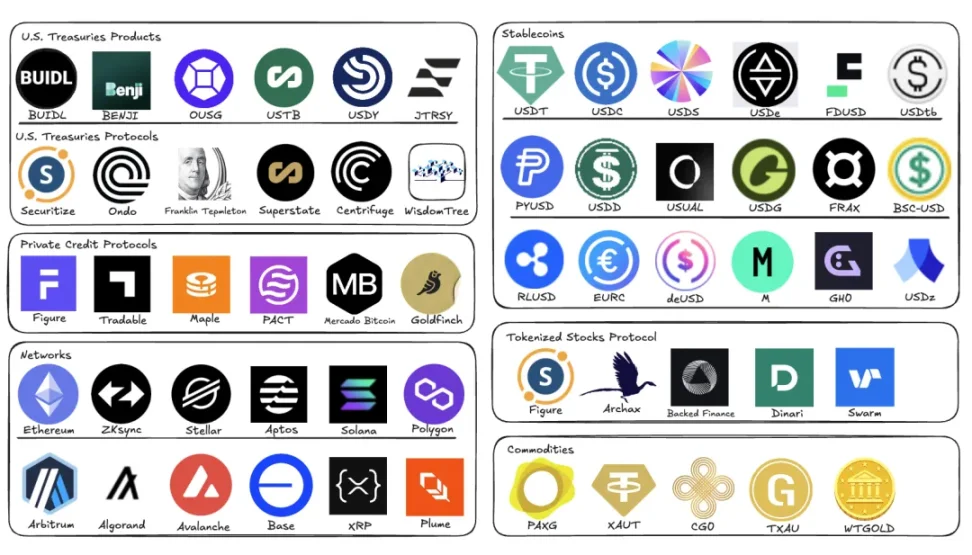
RWA Ecosystem Map, IOSG
Data Analysis: A Panorama of Ethereum RWA Growth
The data clearly shows that the RWA value of Ethereum has entered a distinct growth cycle. Looking at the total value trend of non-stablecoin RWA on Ethereum, its long-term trajectory is noteworthy—maintaining a range of $1-2 billion for years until entering a rapid growth phase in April 2024. This growth momentum continues to accelerate into 2025. The core driving force comes from BlackRock's BUIDL fund, which currently stands at $2.7 billion. As indicated by the orange trend line, BUIDL has shown parabolic growth since March 2025, strongly driving the overall expansion of the Ethereum RWA ecosystem.
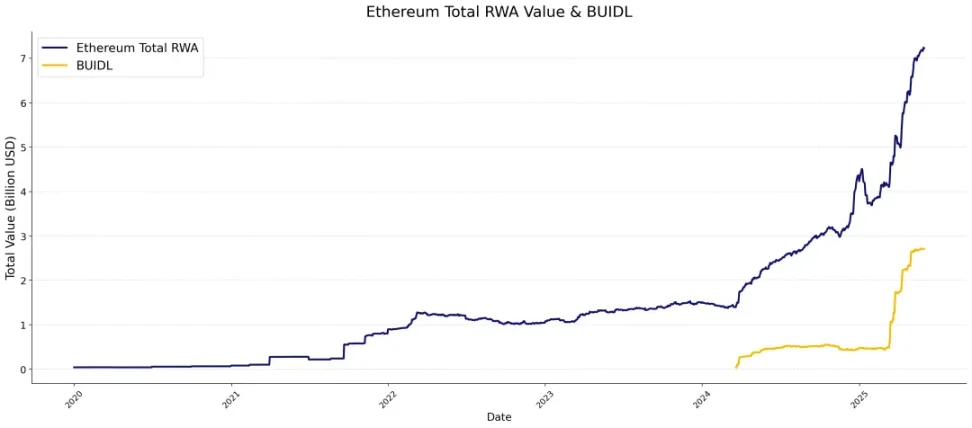
RWA.xyz, IOSG
By asset class (excluding stablecoins), the market value of real-world assets (RWA) on Ethereum is highly concentrated in two main categories: government bond projects (75.9%) and commodities (primarily gold, 20.3%), with other categories being minor. In contrast, in the overall crypto market's RWA market value composition, private credit accounts for the highest proportion (57.4%), followed by government bond projects (30.9%).
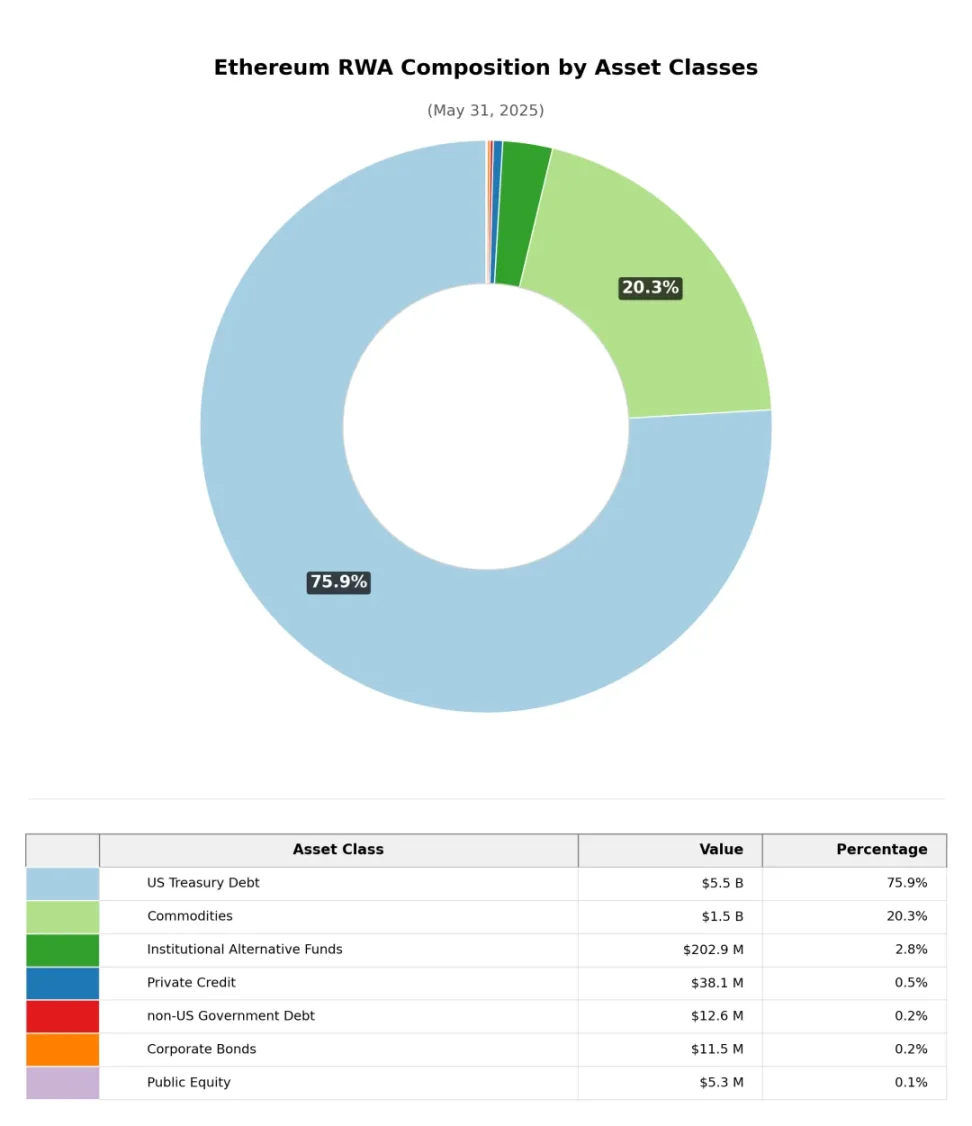
RWA.xyz, IOSG
Focusing further on the leading assets in Ethereum RWA, the pie chart clearly reveals BUIDL's dominant position. A year ago, BUIDL's scale was comparable to products like PAXG and XAUT, but it has now significantly surpassed them. Although the composition of the top ten projects remains relatively stable, the growth rate of government bond products significantly outpaces that of gold products, with market share continuously expanding.
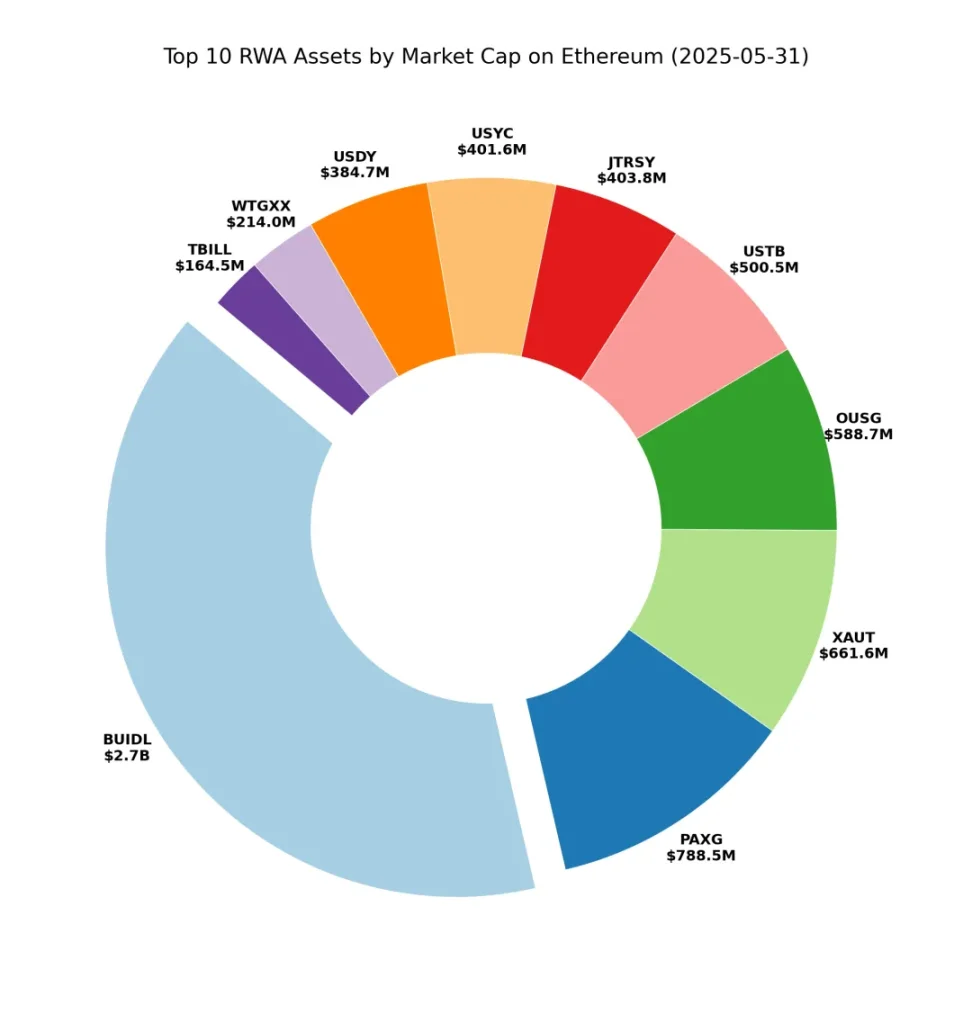
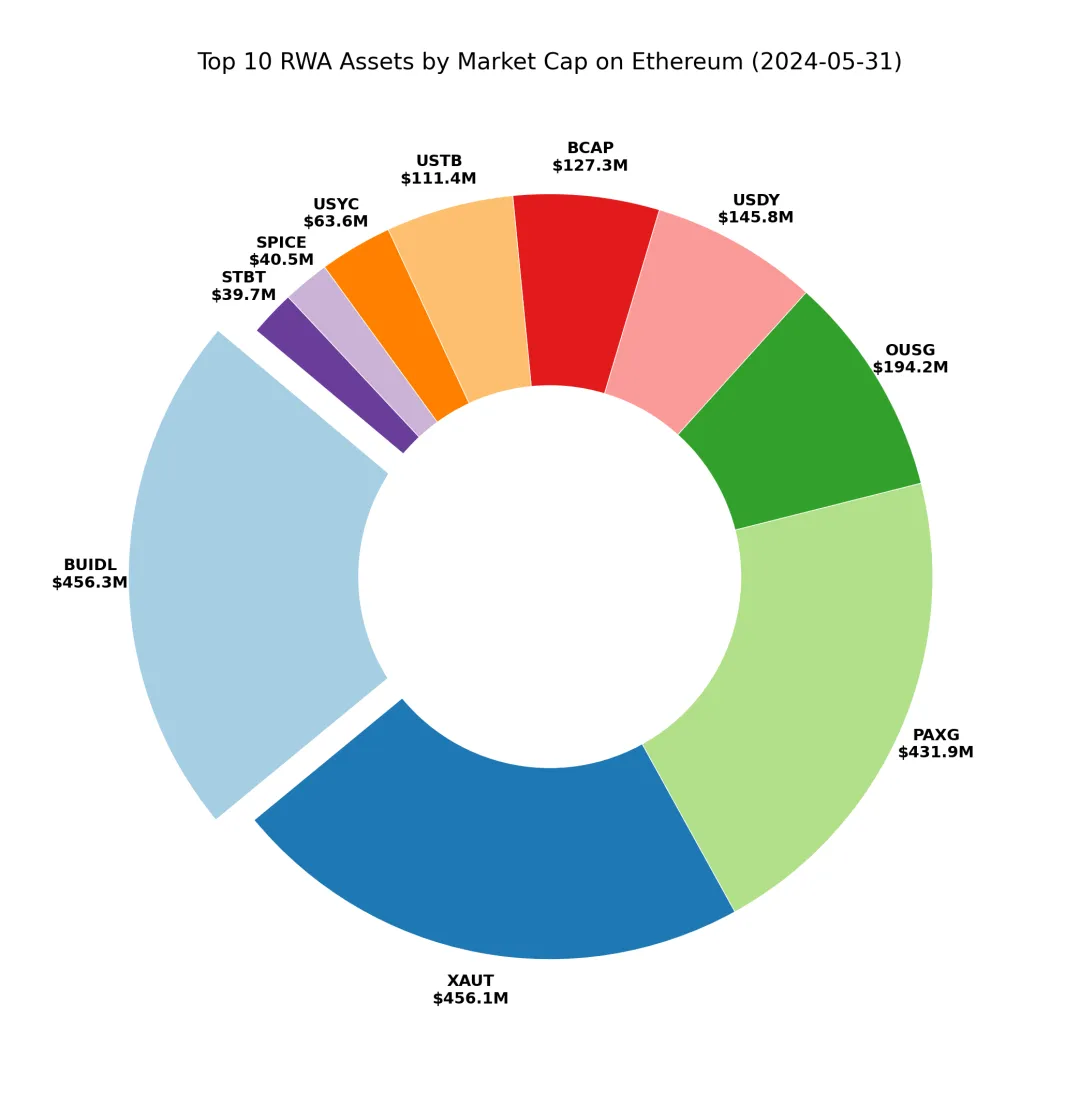
RWA.xyz, IOSG
From a protocol perspective, the current leaders are primarily stablecoin issuers—the top four protocols are Tether, Circle, MakerDAO (Dai stablecoin system), and Ethena. Notably, the total value of the securitization protocol Securitize has significantly surpassed some stablecoin projects like FDUSD and USDC, rising to the forefront. Other securities protocols that made it into the top ten include Ondo and Superstate.
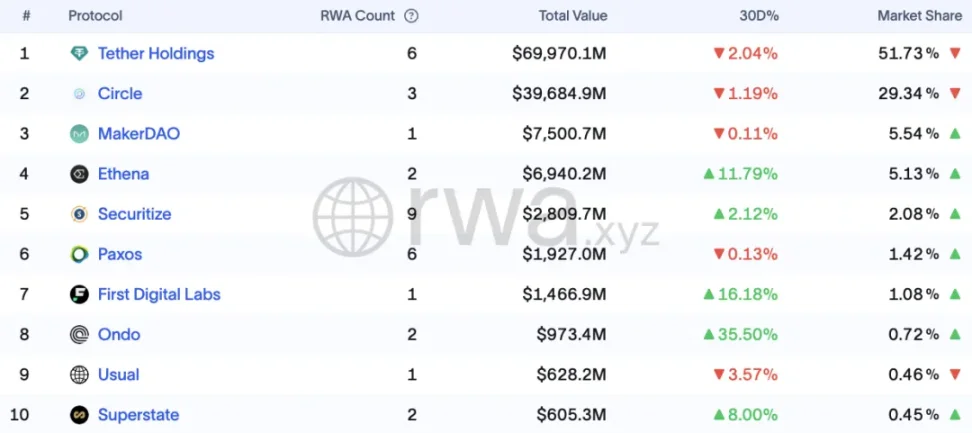
RWA.xyz, IOSG
Focusing on monthly data from early 2024 to the present, the growth wave began in April 2024, achieving an astonishing 26.6% increase that month—contributing a quarter of the total increase in Ethereum RWA. This momentum continued for the next three months, although there was a slight slowdown from August to December 2024, the network still maintained an increase of about $200 million per month (month-on-month growth of about 5%, annualized over 60%).
In January 2025, the growth rate surged again, skyrocketing by 33.2%. After a brief pullback in February, Ethereum maintained double-digit growth for four consecutive months, with both April and May seeing month-on-month increases exceeding 20%.
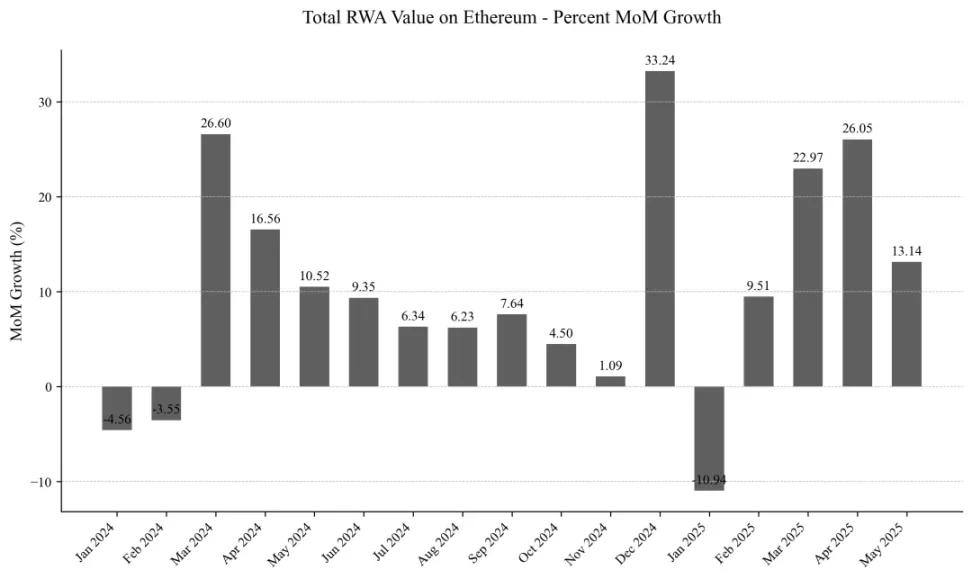
RWA.xyz, IOSG
BUIDL
As BUIDL rapidly rises to become the largest project by market value in the Ethereum RWA ecosystem, a detailed analysis of its growth trajectory is crucial. The month-on-month growth rate chart reveals that as of March 2025, this metric remained relatively stable, followed by an explosive leap in March 2025. However, the latest data from May shows that the hyper-growth trend has slightly slowed, but there was still an increase of $210 million, with a month-on-month growth rate of 8.38%. The developments in the coming months will be a key observation window—tracking whether its growth rate continues to slow down or continues to experience explosive growth.
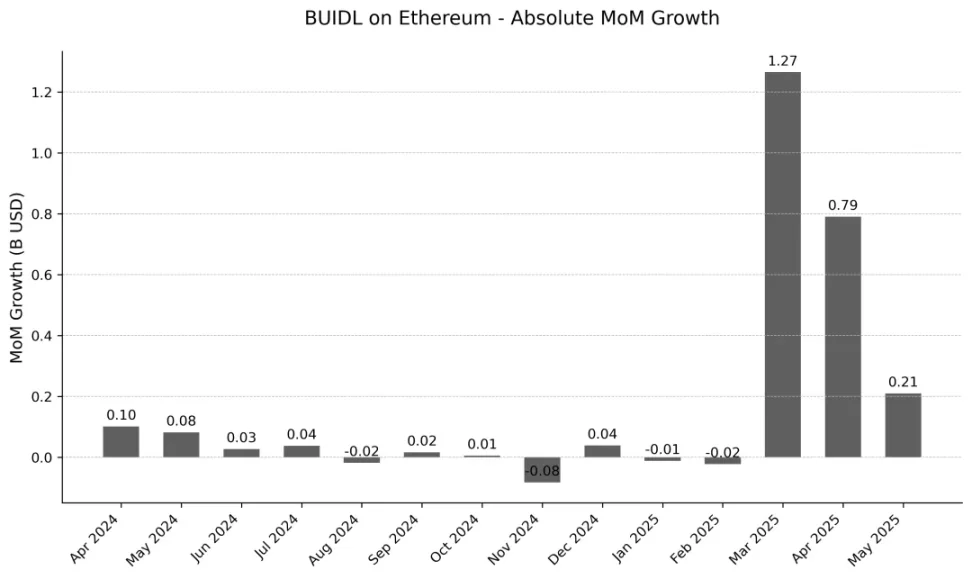
RWA.xyz, IOSG
BUIDL's explosive growth stems from multiple factors. The growth is primarily driven by institutional demand, and the competitiveness of the product is a key driving force for success: including 24/7 operation, faster settlement speeds compared to traditional finance, and high yields within a compliant framework. Notably, DeFi integration is achieving synergies and unlocking more utility, such as Ethena Labs' USDtb product—90% of its reserves are supported by BUIDL. At the same time, the recognition of BUIDL as high-quality collateral continues to rise, with Securitize's launch of sBUIDL further unlocking DeFi integration scenarios.
The asset distribution of BUIDL is highly concentrated: about 93% is concentrated on the Ethereum mainnet, with other ecological chains struggling to catch up. Meanwhile, as the asset management scale continues to expand, BUIDL's monthly dividends have consistently set new highs, reaching $4.17 million in March 2025 and soaring to $7.9 million by May.
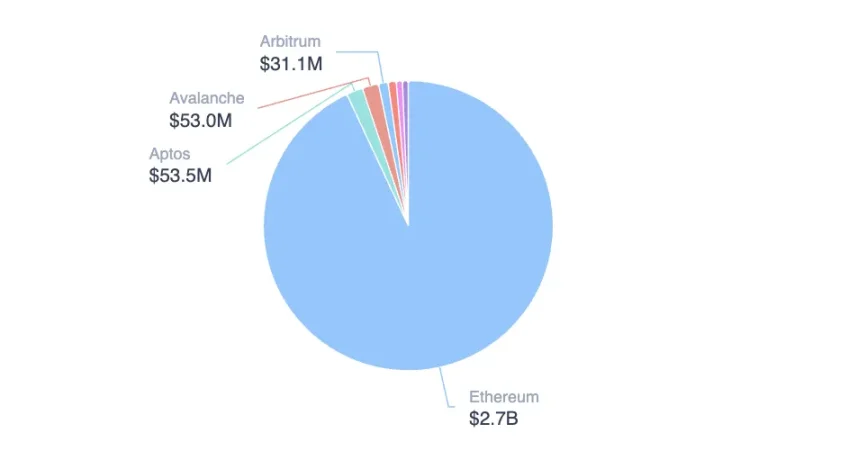
BUIDL Distribution, screenshot from RWA.xyz
Stablecoins
Given that the "GENIUS Act" will have a structural impact on the regulatory framework for stablecoins, systematically examining the development trajectory of the Ethereum stablecoin market is of significant forward-looking importance. Since 2024, the total market value of this sector has shown a steady upward trend, although the growth rate is slightly slower compared to other RWA sub-sectors, it still maintains a resilient monthly growth rhythm.
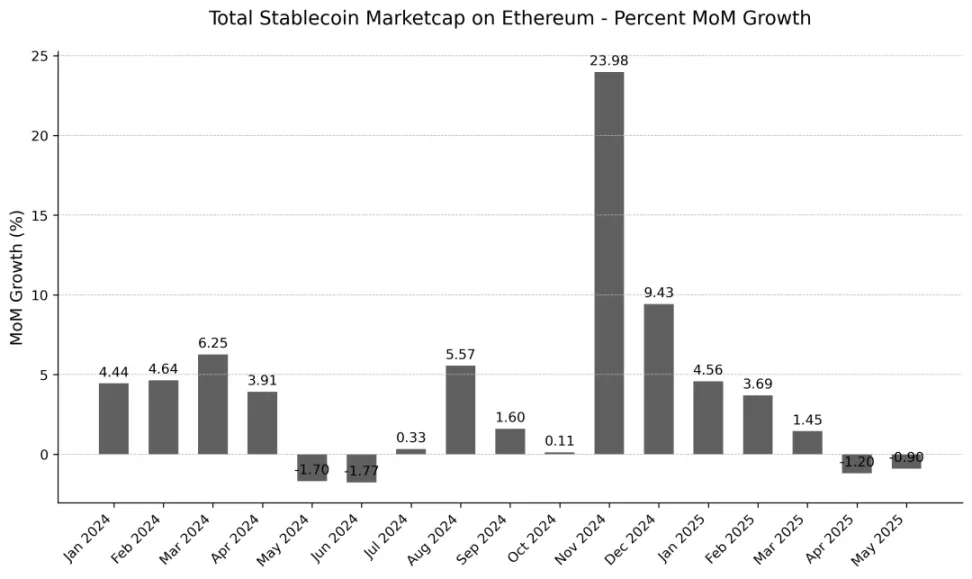
RWA.xyz, IOSG
Among small projects (less than $500 million), most projects experienced continuous contraction since early 2024. However, by the end of 2024, most projects' market values continued to rise, with GHO, M, and USDO showing sustained growth. At the same time, a number of new stablecoin projects have crossed the $50 million market value threshold, making the Ethereum stablecoin ecosystem more diverse, with small-cap projects thriving since 2025.
In the medium-sized project category ($500 million to $5 billion), only FDUSD and FRAX existed in 2024; BUSD saw a sharp decline from $1 billion in January 2024 to less than $500 million by March due to the cessation of issuance. However, in 2025, both USD0 and PYUSD broke through the $500 million threshold, making medium-sized stablecoins more diverse.
The leading stablecoins (over $5 billion) continue to be dominated by USDT and USDC: USDT remained stable at a market value of $40 billion for most of 2024, jumping to $70 billion in early December, and then gradually stabilizing until a recent decline in market value; USDC steadily grew from $22 billion in January 2024 to $38 billion in May 2025. At the beginning of 2025, both USDS and USDe broke through the $5 billion mark, but USDT and USDC still lead significantly in market share.
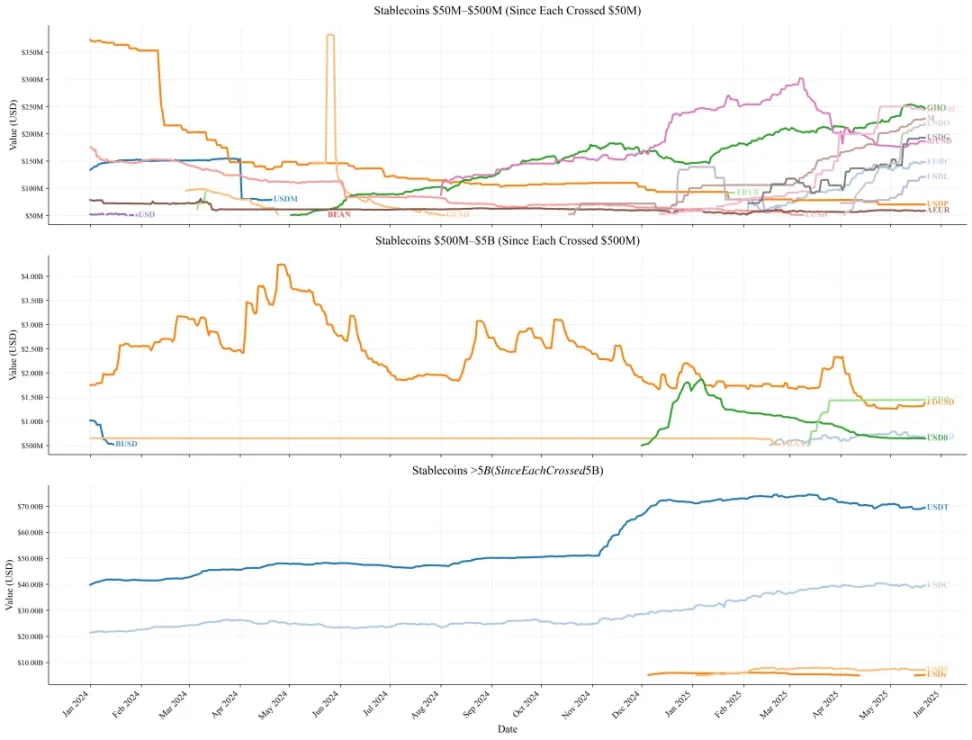
RWA.xyz, IOSG
USDT and USDC dominate the stablecoin ecosystem, directly impacting the entire market.
The growth in November 2024 is particularly noteworthy: USDT surged by 30.16% month-on-month, while USDC achieved a 16.31% increase. Following this spike, there was sustained growth for several months, with USDC showing more robust growth in subsequent months, maintaining a monthly increase of over 5%. According to the issuers, Tether attributes this to "a wave of collateral assets flooding in from exchanges and institutional trading desks in response to anticipated spikes in trading volume"; Circle emphasizes that "the circulation of USDC has increased by 78% year-on-year… stemming not only from user demand but also from the market confidence rebuilding and standard system improvement driven by emerging stablecoin regulatory rules."
However, market momentum has recently shifted noticeably—over the past four months, USDT on the Ethereum chain has stagnated in growth, and in May 2025, USDC experienced its first decline after several months of growth. This phenomenon may signal a market transition into a new cyclical phase.
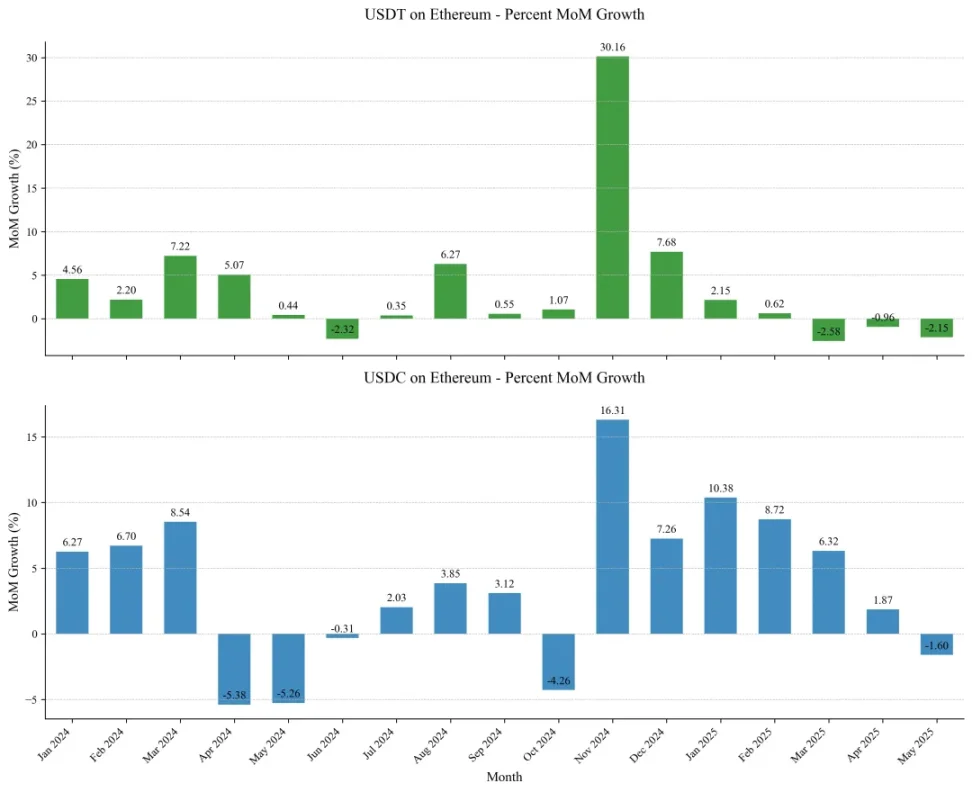
RWA.xyz, IOSG
L2 Ecosystem
In the broader RWA ecosystem, Ethereum maintains an absolute dominant position with a 59.23% market share (excluding stablecoins), but it still faces key challenges.

Screenshot from RWA.xyz
Notably, zkSync has jumped to second place driven solely by the Tradable project, while Stellar relies entirely on the Franklin Templeton BENJI fund (worth $455.9 million) to occupy third place. Despite the impressive on-paper data from these two public chains, their structural flaws cannot be overlooked: a lack of asset diversity and dependence on a single project.
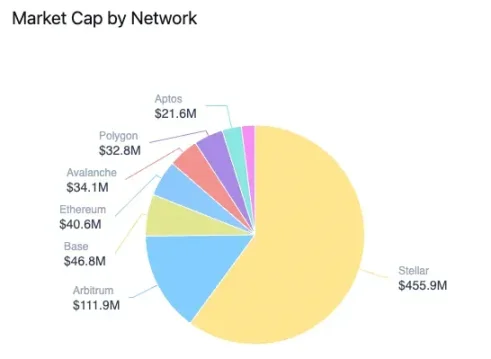
BENJI's Composition, screenshot from RWA.xyz
As demonstrated by the ecological characteristics of zkSync and Stellar, most L2 networks currently face the challenge of insufficient ecological diversity—their RWA market value is highly dependent on 1-2 core projects. For example, in Arbitrum: out of a total market value of $256 million, BENJI contributes $111.9 million (43.7%), and Spiko accounts for $93.5 million (36.5%), together monopolizing over 80% of the market value; Polygon also exhibits a similar distribution pattern, with core market value concentrated in the two projects Spiko and Mercado Bitcoin.
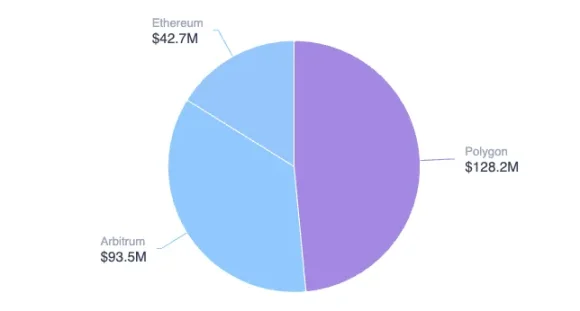
Spiko's Composition, screenshot from RWA.xyz
Expanding the view to the entire L2 ecosystem, the RWA value and market share across networks show significant differentiation (see the table below). Aside from zkSync, only Polygon and Arbitrum have formed substantial scale effects, while other L2s remain in early development stages. The success of Polygon and Arbitrum heavily relies on the single driving force of Spiko—this project contributes about one-third of the total RWA value across both networks.
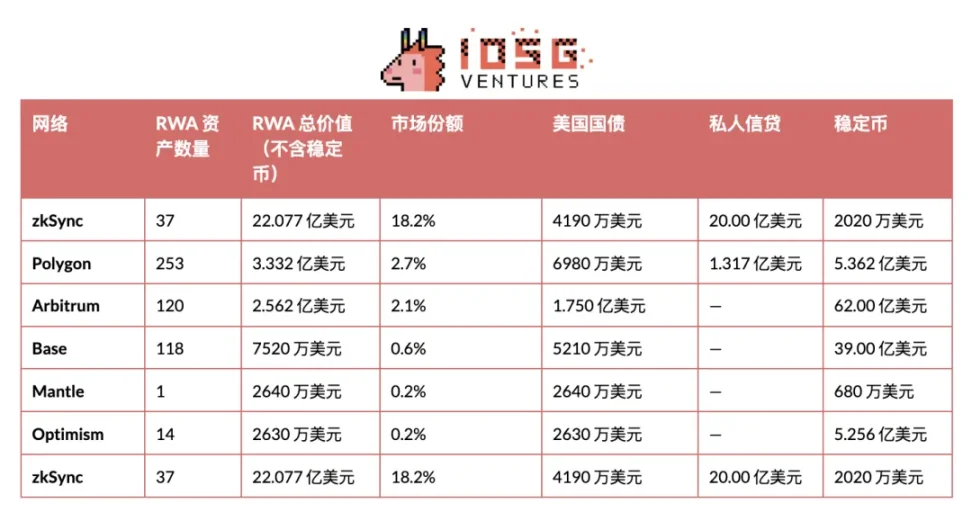
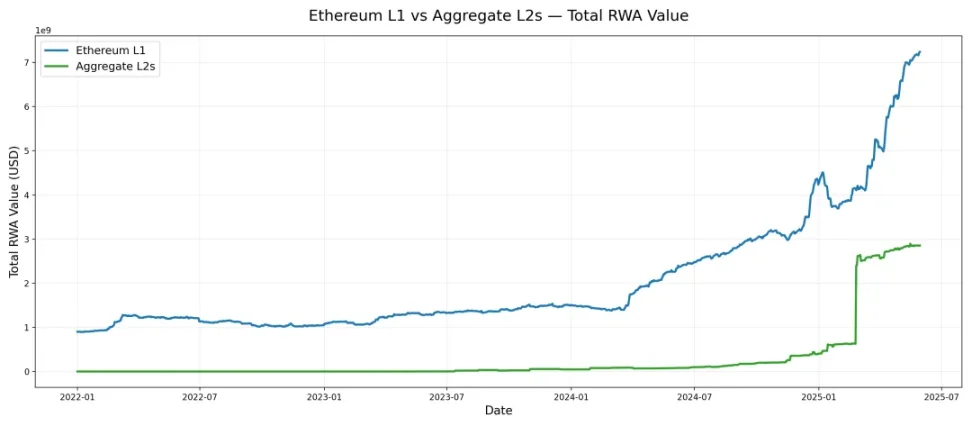
RWA.xyz, IOSG
Looking at the overall evolution of RWA market value across Layer-2 networks, its growth cycle does not completely synchronize with Layer-1: growth did not start simultaneously in mid-2024. The integration of the Tradable project into zkSync brought about a market value increase of around $2 billion. However, even excluding this impact, the growth trend for L2 has still been established—since September 2024, L2 networks have consistently maintained double-digit month-on-month growth. In contrast, the previous phase of RWA expansion exhibited sporadic and weak characteristics. In summary, the end of 2024 marks a turning point for L2 ecosystem RWA development: entering a strong growth cycle.
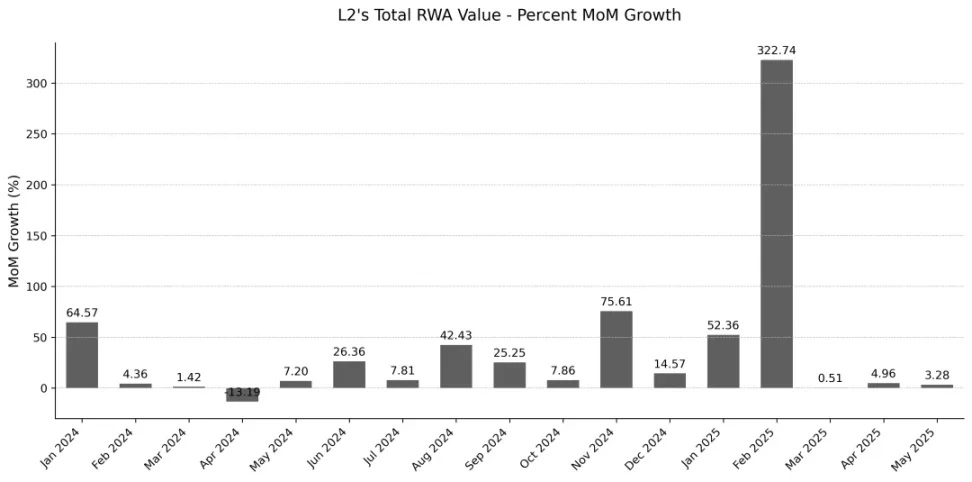
RWA.xyz, IOSG
Etherealize: The New Engine for Ethereum RWA
As a key force driving the adoption of Ethereum RWA, the birth of Etherealize stems from a profound insight into industry bottlenecks: when protocol-level breakthroughs fail to effectively translate into tangible applications, institutional participation often stagnates. To address this, Etherealize systematically bridges the gap between technological breakthroughs and practical implementation by developing customized tools, building strategic cooperation networks, and deeply engaging in policy formulation.
Currently, Etherealize primarily promotes the popularization and application of Ethereum RWA through market education and content dissemination, as well as data dashboard tools. On one hand, the team has written and published several in-depth articles about Etherealize itself and the Ethereum ecosystem, while also participating in various well-known podcasts and interviews with traditional finance and crypto media, significantly influencing the industry through dialogues with thought leaders. On the other hand, Etherealize actively communicates with regulatory agencies, having successfully hosted several seminars and discussions on digital asset compliance and regulatory topics, continuously proposing constructive solutions for how to standardize and advance the RWA process.

Recently, Etherealize founder Vivek Raman was invited to attend a hearing by the House Financial Services Committee on "The Future of American Innovation and Digital Assets," further expanding Etherealize's important role in regulatory communication.
At present, Etherealize has only launched a data dashboard for market education and promotional purposes, but the team has explained in its roadmap that it will develop an SDK for institutions and is currently recruiting founding engineers, making it worth keeping an eye on Etherealize's progress in promoting RWA products.
In the upcoming roadmap, the focus for the second quarter of 2025 is to release an institution-level SDK, which will integrate hosting interfaces, compliance processes, and gas optimization modules, helping banks and asset management institutions establish secure and auditable issuance processes, significantly lowering the barriers for traditional financial institutions to participate in Ethereum RWA.
Building on this, the third quarter will see the launch of a Noir-based enterprise-level wallet pilot project, ensuring privacy protection reaches enterprise-level standards, and meeting the confidentiality needs of RWA transactions through a "default privacy" mechanism.
The fourth quarter will shift focus to international markets: the team plans to establish partnerships with Singapore's Digital Port and Switzerland's Crypto Valley Association, localizing product functions and compliance to address the regulatory environments and market demands in the Asia-Pacific and European regions.
At the same time, to reduce friction between different Layer-2 networks, the team will lead the push for Rollup standardization and build a unified cross-link interface to enable the free flow of assets, thereby integrating RWA under the Ethereum ecosystem and enhancing interoperability.
Finally, to bridge the gap between traditional financial institutions and blockchain technology, the team will continue to adhere to a 24×7 support model, providing end-to-end professional services from legal document preparation to smart contract deployment.
Ethereum RWA Strategic Moat
First-Mover Advantage
The decision-making processes of traditional financial institutions differ from those of DeFi: regulatory reviews, pilot validations, and proof of concepts (PoC) can significantly extend deployment cycles. In the early stages of projects, institutions often adopt a cautious strategy, only initiating expansion after pilot results are validated. Although Ethereum's leading project BUIDL occupies a dominant position, it still experienced explosive growth only after nearly a year of accumulation. Ethereum's core advantage lies in its first-mover status in the ecosystem—having completed experimental collaborations with several top financial institutions well before the RWA wave emerged.
Ecological Accumulation
In addition to institutional collaborations, the maturity of the RWA ecosystem requires long-term accumulation. Ethereum maintains its leadership position through:
Breadth: covering a diverse range of asset issuers and protocol architectures
Depth: multiple projects have market values exceeding $1 billion, forming scale effects
The integration process between traditional finance and DeFi continues to deepen. Most RWA projects prioritize deployment on the Ethereum mainnet, directly utilizing the mature decentralized lending, market-making, and derivatives protocols of the Ethereum ecosystem to enhance capital efficiency. Recent examples include Ethena using BUIDL as 90% of the reserve assets for its USDtb stablecoin. The "GENIUS Act" policy, which mandates stablecoin reserves to tilt towards U.S. Treasury bonds, is driving the integration of U.S. Treasury bonds, on-chain Treasury products, and stablecoin protocols. At the same time, mainstream DeFi protocols are incorporating BUIDL into their core collateral systems.
Ethereum maintains an advantage in RWA liquidity: the number of active addresses, variety of tokens, and liquidity depth all lead the way. Although the Layer-2 ecosystem has uncertainties in collaboration mechanisms, it remains a core path for scaling.
Security
Security is the cornerstone of the RWA ecosystem, and the maturity of smart contract technology is key. As RWA project logic becomes more complex, the requirements for smart contracts also increase. In May 2025, the Cetus protocol on the Sui chain was hacked (resulting in a loss of $223 million), exposing the fatal risks of oracle manipulation and contract vulnerabilities. Although on-chain freezing recovered $162 million, such passive emergency mechanisms highlight the limitations of risk control. In contrast, Ethereum's core advantage lies in its more decentralized architecture, reliable operating records, and a thriving developer ecosystem.
Technological Evolution
The Ethereum technical roadmap will accelerate RWA development. First, it aims to enhance L1 performance to bridge the core gap with high-performance public chains. Second, it will promote L2 interoperability and focus on the application layer, creating a connection channel between traditional finance and on-chain RWA.
At the same time, Ethereum's privacy roadmap will strengthen security standards and privacy protection mechanisms (such as integrating privacy tools into mainstream wallets and simplifying censorship-resistant transaction processes), providing safeguards for RWA transactions and building an asset confidentiality system that meets institutional requirements.
The Genius Act: A Double-Edged Sword
The new stablecoin regulatory framework strengthens centralized control while injecting regulatory certainty into the market. Currently, Section 4(6) of the bill does not explicitly allow stablecoin issuers to pay interest to holders, and although the market may generate alternative solutions, this issue remains uncertain. Additionally, the Genius Act requires stablecoin reserves to be backed 1:1 by U.S. dollars or other highly liquid safe assets like U.S. Treasury bonds.
The reserves of the USDC stablecoin are almost entirely allocated to U.S. Treasury bonds, complying with the new regulations. However, other mainstream issuers will need to completely restructure their reserve frameworks, or they may be forced to exit the U.S. market. This move will directly impact specific designs such as algorithmic stablecoins and Delta Neutral stablecoins.
By anchoring collateral to U.S. sovereign credit, regulators gain stronger intervention capabilities (which simultaneously drives demand for Treasury bonds), but the loopholes in the legislation could lead to new systemic risks—similar to the historical lessons from the 2000 Commodity Futures Modernization Act (CFMA).
On the positive side, the clearly defined compliance boundaries in the bill may accelerate institutional entry: the regulatory certainty long sought by banks and asset management institutions is now being met. More large companies and institutions will gain permission to issue stablecoins. For example, several major U.S. banks are discussing a joint crypto stablecoin, or Meta is reconsidering the possibility of launching a new stablecoin project.
Ethereum's Resilience: A Diverse Ecosystem
The resilience of Ethereum's stablecoin ecosystem stems from its diversity. Since the beginning of 2025, several stablecoin issuers have significantly increased their market value, and numerous new stablecoin projects have emerged, featuring a rich array of design dimensions: diverse collateral structures, yield strategies, and governance models. The Genius Act's mandatory 1:1 Treasury reserve requirement imposes compliance pressure on most projects, forcing them to choose: either adjust their reserve structures or temporarily exit the U.S. market.
The resilience of the Ethereum ecosystem distinguishes it from public chains dominated by a few stablecoin/RWA projects—this reduces the risk of homogenization after projects are widely accepted by regulators. The diverse structure creates a natural risk isolation mechanism: even if some stablecoins adjust their strategies due to compliance requirements, there will still be projects that continue to drive innovation and maintain a decentralized core, not fully becoming part of the Treasury bond system. However, future developments will also depend on the strategic positioning of the Ethereum Foundation and Etherealize.
Conclusion
The Ethereum RWA ecosystem has experienced explosive growth in recent months. Among them, BUIDL has been the strongest driving force behind this RWA development, while numerous Treasury-related projects have also shown strong growth momentum. Behind the scale expansion, Treasury-related projects increasingly demonstrate a trend of integration with Ethereum's existing DeFi and RWA ecosystems, such as BUIDL being used as collateral for lending or stablecoin projects.
Ethereum still holds a significant advantage in the RWA field. Whether it is the first-mover time advantage, security, deep ecological accumulation, grand technological roadmap updates, or BUIDL's strong lead, the diversification of Layer 2, and the deep empowerment of Etherealize, these factors collectively build Ethereum's core barrier in the wave of traditional finance on-chain.
With the push of the Genius Act, U.S. dollar credit is rapidly integrating into the on-chain world. This not only brings a larger influx of funds, creating more revenue and growth opportunities, but also poses a challenge: it makes the underlying support of the Ethereum financial system more biased towards fiat currency (the U.S. dollar), thereby introducing fiat credit risk and potentially making the on-chain settlement system an extension of U.S. dollar hegemony; the on-chain world is no longer an independent parallel financial system. In this context of explosive growth, there are also hidden concerns, primarily centered on Ethereum's exploration of its own positioning—specifically, whether it supports a deep binding with the U.S. dollar system.
免责声明:本文章仅代表作者个人观点,不代表本平台的立场和观点。本文章仅供信息分享,不构成对任何人的任何投资建议。用户与作者之间的任何争议,与本平台无关。如网页中刊载的文章或图片涉及侵权,请提供相关的权利证明和身份证明发送邮件到support@aicoin.com,本平台相关工作人员将会进行核查。




